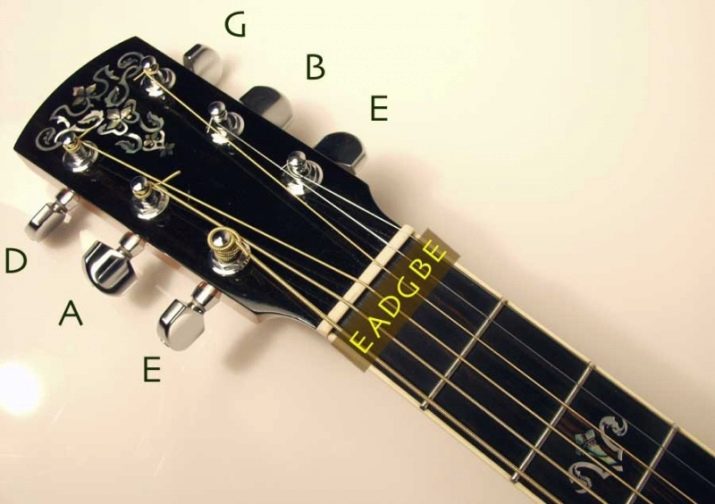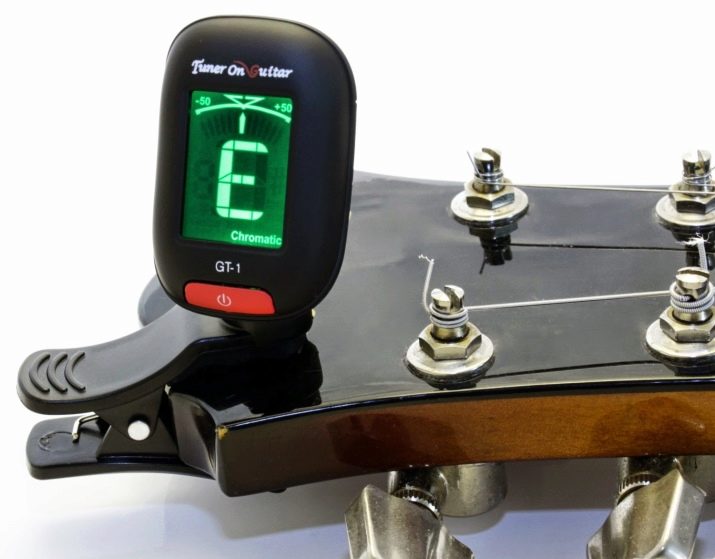Acoustic Guitar Tuning

Buying a guitar is only half the way to learning how to play it, as you first need to get the tuning right. Many beginners think that in order to tune a string instrument, you need to know musical notation and have perfect ear for music. However, there are many simple ways to get your acoustics sound right at home - both with the help of special equipment or online programs, and by ear.

Tuning options
If you go deeper into the matter, you can find a huge number of different tunings for acoustic guitar. But among all the varieties, three stand out: standard, drop-action and open. Let's take a closer look at each of them.
Standard
This group includes not only the classic tuning of a 6-string guitar (EADGBE), but also others, in which the general principle of this tuning is preserved. The standard tuning looks like this: the pitch of the sounds of the first four strings has a quarter interval between them, and the fourth and fifth are tuned to a reduced fifth. Therefore, for example, The DGCFAD guitar tuning is also standard, only having the “D” designation in guitar literature.

Drop D
This tuning of the strings almost completely repeats the standard structure, only the sound of the sixth string is different. It is tuned 1 tone lower - in the interval of an octave to the fourth and in the fifth to the fifth. Thanks to this tuning, it is easier for a musician to clamp fifth chords when performing complex compositions. The drop D tuning is most often used for metal playing.

Open system
A fairly common guitar tuning method for folk musicians.The tuning differs in that it is tuned not in quarter intervals or in fifths, but in the steps of a certain chord. When the guitar is in open tuning, all the strings of the guitar produce a clean chord as specified by the tuner.
For each standard type of tuning, there is the possibility of lowering the tuning (lower tuning from a certain one). To do this, the entire scale is changed to a lower one than the standard one (by semitone or tone).

This method produces a lower and heavier instrument that is best suited for rock music.
The guitar is a versatile musical instrument that can sound, be arranged and tuned in different ways. Acoustic guitars can differ not only in size, but also in the number of strings that have their own standard tuning. Let's take a closer look at several standard tunings of various instruments that are varieties of the guitar.
- Tune a four-string guitar. This instrument is more commonly known as the ukulele. The ukulele has an unusual tuning - all 4 sounds fit into one octave. The default setting for a ukulele is GCEA.
- Tune a seven-string guitar. A guitar with so many strings experienced a peak in popularity between the 18th and 19th centuries. She was in demand among the Gypsies, due to which she received the name "Gypsy". Nowadays, most guitarists prefer the 6-string instrument, but gypsy guitar lovers can still be found. The standard tuning of such an instrument is minor: DGBbDGBbD. The tuning of the "Russian" 7-string is major: DGBDGBD.
- Tune a 12-string guitar. The peculiarity of this tuning is that the strings are arranged in pairs. The main six strings repeat the tuning of the classic 6-string guitar - EADGBE, and the paired strings are tuned a little differently: the first two are tuned in unison with the main ones, and the other four are one octave higher than their pair.


How to use the tuner?
After purchase, you can play the tuned instrument without any problems, but with intense playing, the strings stretch, their sound changes to a lower one. This state of the instrument is called frustrated. In this case, it is necessary to bring the guitar into the correct tuning. For learners on their own, this often becomes a problem, since they do not know how to configure the instrument. But tuning an acoustic guitar isn't a big deal with a sensitive guitar tuner.

Tuning the acoustics using a special device or an online tuner is the easiest, fastest and most high-quality way to bring your guitar to the right tuning for comfortable playing on it. Manufacturers create a wide range of different tuners, so choosing a convenient one will not be difficult.
Self-tuning a guitar using any online tuner is available even for a beginner - it is necessary to connect a microphone and let the program listen to the sounds of the guitar strings in turn. In the event of an incorrect sound on any string, it is necessary to adjust the sound to the desired pitch using the appropriate tuning peg, using the visual aids of the tuner (scale, arrow, signal color or sound).
If you don't have a microphone, you can tune the guitar by ear using the sound produced by the tuner.
Another way to tune the acoustics involves purchasing a special compact tuner. There are 2 types of devices: for acoustics and semi-acoustics. The first device is equipped with a microphone that picks up guitar sounds without pickups and wires. The second tuner, designed to tune the sound of an electric acoustic guitar, is connected to the instrument via a pickup with a conventional jack connection.

To perform tuning using the tuner, you need to connect it to a microphone or sound console. If the second option is used, the sound is displayed on the mixing console.When using a portable tuner clip (clothespin), you just need to attach it to the headstock of your acoustic guitar.
The tuning technology of the instrument using the tuner is quite simple - you need to select a string, extract sounds from it and twist the corresponding peg until the note icon on the display turns green (or the arrow reaches the center mark). Such manipulations must be performed sequentially with each string.

How to tune in by ear?
This method is not the most suitable for beginners, but you should definitely master it so as not to get into an awkward situation in the absence of a tuner. This method is used by almost all professionals who trust their hearing. We invite you to take a closer look at the technique of setting the classical EADGBE tuning.
First string
Guitar tuning always starts with the thinnest string that plays the highest notes. All further technology of the method will be based on its sound. On the first string, you need to tune the sound corresponding to the E note of the first octave. This can be done in several ways: by playing, for example, a similar note on a tuned piano or other musical instrument. And you can also call for help a whistle tuning fork - a very convenient portable device in the form of a tube that you can always carry with you as a key fob. This whistle emits a note "A" (A) of the first octave, in the tone of which you need to tune the first string by pressing it at the 5th fret. When open, it will play the desired note E.

The second
It must be tuned to the B note of a minor octave. The tuned sound of the first string will help with this. Press the second string down to the 5th fret and tune it so that it sounds in unison with the first string open. Once tuned, the open second string will sound like a clean B note.
The third
There is a peculiarity in this place - for tuning, the third string is pressed not on the 5th, like the others, but on the 4th fret. By pressing it, you should make it sound the same with the open second. An open third string will produce a G.

Fourth
It is tuned to the D note by pressing it down to the 5th fret, and then sounding the same with the third string. Further tuning of the guitar will follow the same pattern.
The fifth
Like the previous one, this string is clamped at the 5th fret and tunes in unison with the 4th. Its open sound is the note A.
Sixth
The thickest string is tuned in the same way - clamped at the 5th fret and tune in unison with the previous bass. The sixth string is also an E, like the first, but its sound is two octaves lower.

We use other devices
In addition to tuning by the tuner and by ear, there is tuning by harmonics. This method allows you to achieve maximum accuracy in the sounding of notes. The harmonic technique is an unusual way of picking notes, in which the strings are not clamped at the fret. They only lightly press the left finger over a certain nut of the neck. While plucking the string, the technique involves the simultaneous removal of the finger from it.

If the harmonics are pulled closer to the nut, the sounds are very high, on some strings they even go beyond the upper limit of the guitar, while above the 12th fret, the sound is the same in sound as an open string.
Tuning the guitar to the harmonics is a little more difficult, but this method additionally trains the ear of a novice musician. Let's take a closer look at this method of setting up an instrument.
- The 6th string is tuned in unison with the open 1st harmonic of the 5th fret.
- The 5th is tuned to the harmonic of the seventh fret to match the open 1st.
- The 4th string on the 7th fret harmonic should sound in unison with the 5th string harmonic at the 5th fret.
- The 3rd is tuned through the 7th fret harmonic in unison with the 4th string harmonic at the 5th fret.
- The 2nd string flask, when played at the 5th fret, must match the 1st string harmonic at the 7th fret.

The video below will tell you how to tune an acoustic guitar.








